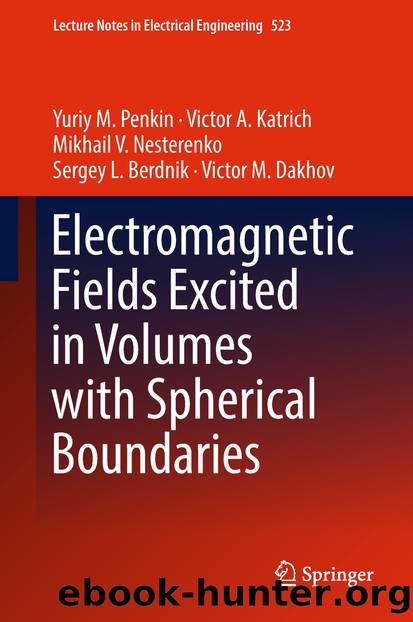Electromagnetic Fields Excited in Volumes with Spherical Boundaries by Yuriy M. Penkin & Victor A. Katrich & Mikhail V. Nesterenko & Sergey L. Berdnik & Victor M. Dakhov

Author:Yuriy M. Penkin & Victor A. Katrich & Mikhail V. Nesterenko & Sergey L. Berdnik & Victor M. Dakhov
Language: eng
Format: epub
ISBN: 9783319978192
Publisher: Springer International Publishing
4.1 Radiation Fields of Dipoles Located on Perfectly Conducting Sphere
4.1.1 Fields of Radial Electric Dipole
Consider a perfectly conducting sphere, excited by radially oriented elementary electric dipole located in an isotropic homogeneous medium (Fig. 3.â1). The sphere radius is R and medium parameters are and . The density of the dipole current is defined by (4.1) under conditions and . Then, using the expressions (1.â45) for the Greenâs tensor components and the functions (3.â7), we can write, in accordance with (1.â30), the radial component of the electric Hertz vector in the form (3.â17) with the complex amplitude .
The magnetic fields can be conveniently found if the Hertz vector of the electric type is used, while the electric fields can found using the magnetic Hertz vector. Hereafter, we will follow this choice. Of course, expressions for all other components of the electromagnetic field can be easily determined.
According to (1.â8), the components of the magnetic field and can be determined using the formulas (2.â14), and the field is zero, since the exciting field is of the electric type. Expressions for and can be written as,
Download
This site does not store any files on its server. We only index and link to content provided by other sites. Please contact the content providers to delete copyright contents if any and email us, we'll remove relevant links or contents immediately.
| Automotive | Engineering |
| Transportation |
Whiskies Galore by Ian Buxton(41718)
Introduction to Aircraft Design (Cambridge Aerospace Series) by John P. Fielding(33016)
Small Unmanned Fixed-wing Aircraft Design by Andrew J. Keane Andras Sobester James P. Scanlan & András Sóbester & James P. Scanlan(32684)
Craft Beer for the Homebrewer by Michael Agnew(18081)
Turbulence by E. J. Noyes(7893)
The Complete Stick Figure Physics Tutorials by Allen Sarah(7264)
Kaplan MCAT General Chemistry Review by Kaplan(6822)
The Thirst by Nesbo Jo(6756)
Bad Blood by John Carreyrou(6476)
Modelling of Convective Heat and Mass Transfer in Rotating Flows by Igor V. Shevchuk(6353)
Learning SQL by Alan Beaulieu(6158)
Weapons of Math Destruction by Cathy O'Neil(6084)
Man-made Catastrophes and Risk Information Concealment by Dmitry Chernov & Didier Sornette(5877)
Digital Minimalism by Cal Newport;(5586)
Life 3.0: Being Human in the Age of Artificial Intelligence by Tegmark Max(5403)
iGen by Jean M. Twenge(5321)
Secrets of Antigravity Propulsion: Tesla, UFOs, and Classified Aerospace Technology by Ph.D. Paul A. Laviolette(5237)
Design of Trajectory Optimization Approach for Space Maneuver Vehicle Skip Entry Problems by Runqi Chai & Al Savvaris & Antonios Tsourdos & Senchun Chai(4956)
Electronic Devices & Circuits by Jacob Millman & Christos C. Halkias(4864)
